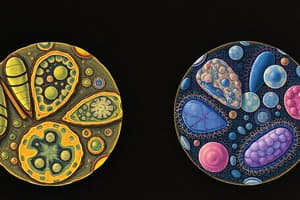Podcast
Questions and Answers
Which term describes an object that is larger than another but not the largest among several?
Which term describes an object that is larger than another but not the largest among several?
- Biggest
- More
- Smaller
- Bigger (correct)
What does the term 'least' signify in a comparison among objects?
What does the term 'least' signify in a comparison among objects?
- The average quantity
- The smallest quantity (correct)
- An equal quantity
- The largest quantity
If an object is described as 'smaller', what implication does it have in relation to another object?
If an object is described as 'smaller', what implication does it have in relation to another object?
- It is the largest of all objects.
- It is of equal size to another object.
- It is larger than one object but smaller than another.
- It is simply less in size compared to another object. (correct)
Which of the following terms indicates the uppermost size comparison among multiple objects?
Which of the following terms indicates the uppermost size comparison among multiple objects?
Which term would you use to compare two objects and highlight one as being larger without absolute magnitude?
Which term would you use to compare two objects and highlight one as being larger without absolute magnitude?
Flashcards
Bigger
Bigger
Describes something as having a greater measurement.
Smaller
Smaller
Describes something as having a smaller measurement.
Biggest
Biggest
Describes the object with the largest measurement.
Smallest
Smallest
Signup and view all the flashcards
More
More
Signup and view all the flashcards
Study Notes
Comparing Sizes
-
Relative Size: Describing size involves comparing objects to other objects or to a known standard. Bigger and smaller are relative terms; something is bigger or smaller than something else.
-
Absolute Size: Describing size by referencing a standard unit of measurement (e.g., millimeters, inches, feet) creates an absolute size.
-
Comparative Adjectives: Words like "bigger," "smaller," "biggest," and "smallest" describe the relative sizes of objects or groups of objects.
-
Quantifiers: Words like "more" and "less" are used to compare quantities. For example, "this pile has more sand than that pile."
-
Superlative Adjectives: "Biggest" and "smallest" indicate the extreme end of a size spectrum within a group of objects. For instance, the tallest building in a city is the biggest building.
-
Size Hierarchies: Objects can be ranked in a hierarchy based on their size. The hierarchical order can be from smallest to biggest (or the reverse), to aid comparative analysis.
-
Using "with" and "without": These words are used comparatively to denote additions or subtractions in relation to size, either comparing an object with another or with its previous size.
Examples of Comparison
-
A car is bigger than a bicycle.
-
A grain of rice is smaller than a grapefruit.
-
The elephant is the biggest animal in the zoo.
-
A single grain of sand is the smallest part of a sandcastle.
-
This box has more candies than that box.
-
The smallest ant is less than 0.01 inches long.
-
A water bottle with a lid is bigger than the same water bottle without the lid (because the lid has added size).
-
A table with a lamp on it has more bulk than the same table without the lamp.
-
A piece of cake is bigger than a single cookie.
-
A dog is bigger than a cat.
-
Five apples are more than two apples.
Studying That Suits You
Use AI to generate personalized quizzes and flashcards to suit your learning preferences.




